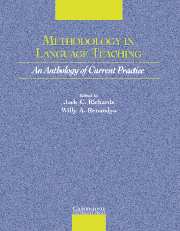Book contents
- Frontmatter
- Contents
- Acknowledgments
- Introduction
- Section I Approaches to Teaching
- Section 2 Lesson Planning and Classroom Management
- Section 3 Classroom Dynamics
- Section 4 Syllabus Design and Instructional Materials
- Section 5 Task and Project Work
- Section 6 Learning Strategies
- Section 7 Teaching Grammar
- Section 8 Teaching Pronunciation
- Section 9 Teaching Speaking
- Chapter 18 Factors to Consider: Developing Adult EFL Students' Speaking Abilities
- Chapter 19 Conversational English: An Interactive, Collaborative, and Reflective Approach
- Chapter 20 Developing Discussion Skills in the ESL Classroom
- Section 10 Teaching Listening
- Section 11 Teaching Vocabulary
- Section 12 Teaching Reading
- Section 13 Teaching Writing
- Section 14 Assessment
- Section 15 Technologies in the Classroom
- Section 16 Professional Development
- Credits
- Author Index
- Subject Index
- References
Chapter 20 - Developing Discussion Skills in the ESL Classroom
Published online by Cambridge University Press: 10 November 2010
- Frontmatter
- Contents
- Acknowledgments
- Introduction
- Section I Approaches to Teaching
- Section 2 Lesson Planning and Classroom Management
- Section 3 Classroom Dynamics
- Section 4 Syllabus Design and Instructional Materials
- Section 5 Task and Project Work
- Section 6 Learning Strategies
- Section 7 Teaching Grammar
- Section 8 Teaching Pronunciation
- Section 9 Teaching Speaking
- Chapter 18 Factors to Consider: Developing Adult EFL Students' Speaking Abilities
- Chapter 19 Conversational English: An Interactive, Collaborative, and Reflective Approach
- Chapter 20 Developing Discussion Skills in the ESL Classroom
- Section 10 Teaching Listening
- Section 11 Teaching Vocabulary
- Section 12 Teaching Reading
- Section 13 Teaching Writing
- Section 14 Assessment
- Section 15 Technologies in the Classroom
- Section 16 Professional Development
- Credits
- Author Index
- Subject Index
- References
Summary
INTRODUCTION
Discussion skills are often undeveloped in the EFL/ESL classroom. A combination of potent inhibitors are responsible for this situation: large class size, students' level of proficiency and time constraints. As a result, many teachers never attempt discussions or, as a result of negative experiences, simply stop holding them. A solution adopted by many teachers involves the use of structured or guided discussions. These typically provide a framework within which learners are constrained to operate. Learners receive content input just before the discussion itself; they are then given roles to play, and follow predetermined steps through to the end of the discussion. Language prompts or appropriate wordings are usually provided. Finally, the teacher provides feedback on the whole performance. Examples of this approach, including some exceptionally good ones, are to be found in Alexander (1968), Wallace (1980), Hargreaves and Fletcher (1981), Heyworth (1984) and Ur (1981).
Although the guided approach provides some security for learners, and may help prevent communication breakdown, there is little direct learner involvement in the discussion process. Learners do not choose the topic, or decide on specific lines of enquiry to pursue; nor are they engaged in observing and evaluating their peers or themselves. The learner's perception may be that there is no real reason to participate actively in the discussion. As a result, learner cognitive engagement with the task, and motivation to develop the topic to any significant degree, are likely to be poor.
- Type
- Chapter
- Information
- Methodology in Language TeachingAn Anthology of Current Practice, pp. 225 - 234Publisher: Cambridge University PressPrint publication year: 2002
References
- 3
- Cited by



